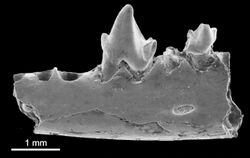Biology:Adapisoriculidae
From HandWiki
Short description: Extinct family of eutherian mammals
| Adapisoriculidae | |
|---|---|

| |
| Jaw fragment of Bustylus marandati | |
| Scientific classification | |
| Domain: | Eukaryota |
| Kingdom: | Animalia |
| Phylum: | Chordata |
| Class: | Mammalia |
| Clade: | Eutheria |
| Family: | †Adapisoriculidae Van Valen (1967) |
| Genera | |
| |
Adapisoriculidae is an extinct family of non-placental eutherian mammals present during the Paleogene and possibly the Late Cretaceous. They were once thought to be members of the order Erinaceomorpha,[7] closely related to the hedgehog family (Erinaceidae), because of their similar dentition, or to be basal Euarchontans.[8] They were also thought to be marsupials at one point. Most recent studies show them to be non-placental eutherians, however.[9]
They were small mammals of about 15 cm long, with a tail of equal length. They were probably nocturnal, eating insects and fruits.
Deccanolestes and Sahnitherium from the Late Cretaceous of India may be Cretaceous members of Adapisoriculidae.
References
- ↑ "PBDB". https://paleobiodb.org/classic/checkTaxonInfo?taxon_no=118857&is_real_user=1.
- ↑ "Paleobiology Database: Afrodon". Paleodb.org. http://paleodb.org/cgi-bin/bridge.pl?a=basicTaxonInfo&taxon_no=118856. Retrieved 2011-11-02.
- ↑ Gheerbrant, Emmanuel (1991). "Bustylus (Eutheria, Adapisoriculidae) and the absence of ascertained marsupials in the Palaeocene of Europe". Terra Nova 3 (6): 586–92. doi:10.1111/j.1365-3121.1991.tb00200.x. Bibcode: 1991TeNov...3..586G.
- ↑ "Genera and species of Paleocene mammals - Part 2". Paleocene-mammals.de. http://www.paleocene-mammals.de/pal2.htm. Retrieved 2011-11-02.
- ↑ Goin, F. J.; Crespo, V. D.; Pickford, M. (2022). "A new adapisoriculid mammal (Eutheria) from the early-middle Eocene of Namibia". Communications of the Geological Survey of Namibia 25: 56–65. https://www.mme.gov.na/files/publications/Comms%20GSN%2025,%202022,%20pp.%2056-65,%20Goin%20et%20al.pdf.
- ↑ "Paleocene mammal faunas of Europe". Paleocene-mammals.de. http://www.paleocene-mammals.de/pal-eu.htm. Retrieved 2011-11-02.
- ↑ Agusti, Jordi; Anton, Mauricio (2002). Mammoths, Sabertooths, and Hominids: 65 Million Years of Mammalian Evolution in Europe. Columbia University Press. ISBN 0-231-11640-3.
- ↑ Smith, Thierry; Bast, Eric; Sigé, Bernard (2010). "Euarchontan affinity of Paleocene Afro-European adapisoriculid mammals and their origin in the late Cretaceous Deccan Traps of India". Naturwissenschaften 97 (4): 417–22. doi:10.1007/s00114-010-0651-5. PMID 20174778. Bibcode: 2010NW.....97..417S.
- ↑ Carly L. Manz, Stephen G. B. Chester, Jonathan I. Bloch, Mary T. Silcox, Eric J. Sargis, New partial skeletons of Palaeocene Nyctitheriidae and evaluation of proposed euarchontan affinities, Published 14 January 2015.DOI: 10.1098/rsbl.2014.0911
Wikidata ☰ Q3775516 entry
 |

